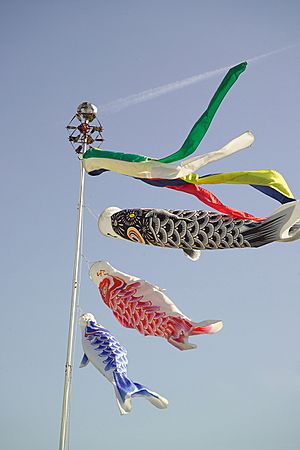Children's Day (Japan) facts for kids

Children's Day (こどもの日 (Kodomo no hi)) is a public holiday in Japan. It happens every year on May 5th. This day is the last celebration in Golden Week. It's a special day to respect children and celebrate their happiness. The Japanese government made it a national holiday in 1948. But people have celebrated it in Japan for a very long time.
Since 1948, Children's Day has been for both boys and girls. However, its older name, Tango no Sekku, was mainly for boys. This tradition started around the 12th century. Some customs from that time are still part of Children's Day today.
Contents
History of Children's Day
The day was first called Tango no sekku (端午の節句). It was one of the five main yearly ceremonies at the emperor's court. It was celebrated on the fifth day of the fifth month in the old Lunisolar calendar.
Tango no Sekku was first a day for women. They would clean houses and use irises. People believed irises could keep away bad spirits. But in the Kamakura period (1185–1333), it became a day for boys. This happened when the samurai warriors took control of the government. Irises were seen as a samurai plant. Their leaves looked like Japanese sword blades. Also, the word shōbu (尚武), meaning "to value fighting," sounded like the word for iris (菖蒲). So, irises were lucky for samurai. During this time, yabusame (horseback archery) was held on May 5th to keep away evil.
Displaying Armor and Helmets
The custom of showing off mini Japanese armor and kabuto (helmets) on Children's Day started around the Kamakura to Muromachi periods (1333–1573). This display is called Gogatsu Ningyo (May doll). Samurai used to take out their armor, kabuto, and swords in May. They did this before the rainy season to clean and care for them. Since this was also the time of Tango no Sekku, they began to display these items. They hoped this would protect their children.
During the Edo period (1603–1867), Tango no Sekku parties became very grand. Samurai families started to show samurai dolls (Musha Ningyo, 武者人形). They also displayed real armor, kabuto, and swords. Regular families began to display paper kabuto. People also started taking baths with irises on May 5th during this time.
The Story of Koinobori
The custom of decorating with koinobori (carp streamers) also began in the Edo period. Samurai families would hang nobori or fukinuke (吹貫) flags in their yards. These flags had family symbols (mon) and showed military groups. Later, nobori and fukinuke combined, and the first koinobori appeared in Edo (now Tokyo). The colorful koinobori we see today became popular in the Meiji era (1868–1912).
From Boys' Day to Children's Day
After Japan started using the Gregorian calendar, the date moved to May 5th. Until 1948, Children's Day was known as Boys' Day. It celebrated boys and honored fathers. It was like Hinamatsuri, or "Girl's Day," on March 3rd. In 1948, the name changed to Children's Day. This was to include both boys and girls. It also recognized mothers, fathers, and family togetherness.
In the Showa era (1926–1989), miniature armor became more popular than samurai dolls. Since the 21st century, small kabuto have become very popular. This is probably because Japanese houses are often smaller now.
-
Ukiyo-e by Utagawa Hiroshige depicting koinobori. Edo period
How Children's Day is Celebrated
On Children's Day, families raise koinobori. These are carp-shaped windsocks. There's a Chinese legend that a carp swimming upstream becomes a dragon and flies to Heaven. The waving windsock looks like a swimming fish. A black carp is for the father. A red or pink one is for the mother. And there's one carp (usually blue, sometimes green or orange) for each child. When it was Boys' Day, the red koinobori was for the oldest son. Blue and other colors were for younger brothers.
May Dolls and Heroes
Today, Japanese families usually display miniature Japanese armor and kabuto. These are called Gogatsu Ningyo (May doll). These dolls often look like ō-yoroi or dō-maru armor. This style was popular in the Heian (794–1185) and Kamakura periods (1185–1333). It looks more fancy than later armor styles. There are also kabuto made to fit a boy's head, which can actually be worn. The full Gogatsu Ningyo display is on a tiered shelf. It includes a yumi (bow), tachi (long sword), Japanese war fan, and jingasa (samurai hats).
Before the Edo period, samurai dolls were more common than miniature armor. Japanese folk heroes were often chosen as subjects for these dolls. Some popular heroes were Momotarō, Kintarō, Ushiwakamaru, Benkei, Emperor Jinmu, and Shoki.
Traditional Foods and Iris Customs
Kashiwa mochi and chimaki are traditional foods served on this day. Kashiwa mochi are sticky rice cakes filled with red bean jam. They are wrapped in oak leaves. The oak leaf is special because its old leaves don't fall off until new ones appear. This makes it a good luck charm for family growth. Chimaki is sticky sweet rice wrapped in an iris or bamboo leaf.
Irises are believed to have healing powers and to keep away evil. So, they are used in many ways on May 5th. For example, people take baths with irises in the bathtub. Some soak thin iris roots or leaves in sake and drink it. Others put irises in thin washi (Japanese traditional paper) and place it in their pillows before bed.
-
Gogatsu Ningyo from the Taishō era or early Shōwa era. Miniature armor in the ō-yoroi style (center), Samurai dolls featuring Shoki and Emperor Jinmu (back left and right), Samurai dolls wearing armor in the ō-yoroi and tosei gusoku styles (front)
Related pages
See also
 In Spanish: Kodomo no Hi para niños
In Spanish: Kodomo no Hi para niños









